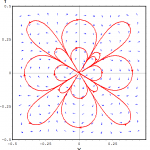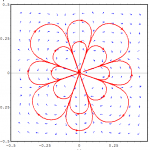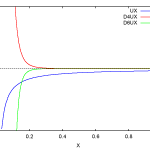Very interesting graphical results and a very useful code! I think that this is the most general method of calculating the effect of the vacuum,, because the tensorial Taylor series is completely general. These graphics are already full of interest. In the next note I will first indicate how the spin connection is computed, then introduce well known expressions for the Dirac delta function, so that del squared (1 / r) is no longer zero. Then the program can compute the distortions to the Dirac delta function due to the vacuum. I will also write out a few example fields, notably the inverse square law and the dipole field. The program can then compute the vacuum distortions. Then UFT396 can be written up. There is an infinite number of applications for this new method.
Date: Tue, Jan 2, 2018 at 6:36 PM
Subject: UFT 396: Graphics for Tensorial Taylor Expansion
To: Myron Evans <myronevans123>
I calculated the Taylor terms for the magnetic dipole vector potential and the scalar Coulomb potential. The quadratic terms vanish in both cases, the 4th and 6th order terms are non-zero. Figs are as follows:
Fig. 1: undistorted vector potential
Fig. 2: 4th-order fluctuation potential
Fig. 3: 6th-order fluctuation potential
Fig. 4: sum of all three contributions
Fig. 5: original Coulomb potential (UX) with 4th and 6th order corrections
Fig. 6: original Coulomb potential (UX)and trotal potential with fluctuations
For the vector potential both corrections give the same symmetry. The Coulomb potential is made more steep by the corrections, seems to give an effect like an extended source, compared to the original point source.
Horst
Am 02.01.2018 um 18:39 schrieb Horst Eckardt:
I worked out the full eq.(14) by Maxima code. It can be programmed quasi-recursive. It comes out that all odd exponents of (delta r * del) give zero results (up to eq. o34 of the protocol). As examples I used the vector potential of a magnetic dipole and the Coulomb potential. In both cases the second-order terms vanish due to the symmetry
<dX^2> = <dY^2> = <dZ^2> = 1/3 * <dr^2>.
In constrast to the earlier method with 1/x expansion, now the orders of expansion are complete, for example fourth order gives all fourth order terms, and no terms of lower or higher order. I will send over some plot examples later.
Horst
Am 02.01.2018 um 13:53 schrieb Myron Evans:
In this note it is demonstrated by detailed calculation that the tensorial Taylor expansion (1) is the same as the very condensed notation vector Taylor expansion (7). The clearest expression however is Eq. (14), in Cartesian components. Although Eq. (14) looks complicated it is easily worked out with computer algebra, thus eliminating human error. The meaning of isotropic averaging is most clearly explained with Cartesian components as in Eqs. (8) to (10). This method can be used to find the effect of the vacuum to any order of the Taylor series on any scalar function of of physics. The Lamb shift is explained with this general and powerful method, used to second order with f being the Coulomb potential between the proton and electron in the H atom. In reading around this subject using google, and doing a literature search, I found all kinds of obscurities and amateurish errors, sloppy notation, sloppy articles, and so on. Horst Eckardt, Douglas Lindstrom and I always aim for maximum precisipn and clarity. This is achieved only after years of hard work and multiple cross checks. This is why ECE theory is so spectacularly successful, and in my opinion, why wikipedia and much of standard physics is such a dismal, dogmatic failure. Every single wikipedia article I have studied had to be entirely rewritten because of errors and obscurities. In other areas wikipedia may be fairly useful, but in theoretical physics it is not of much help, and a decade ago, was used to launch a personal attack on myself, using abuse and fraud. This attack failed completely. Google is useful, because it is effectively a huge library, but there is no quality control, and some of the stuff dredged up by Google is appallingly bad. Other stuff is good. One just has to use great care and experience, and above all, work it all out for yourself as in this note.
-

-
fig1
-

-
fig2
-

-
fig3
-

-
fig4
-

-
fig5
-

-
fig6





